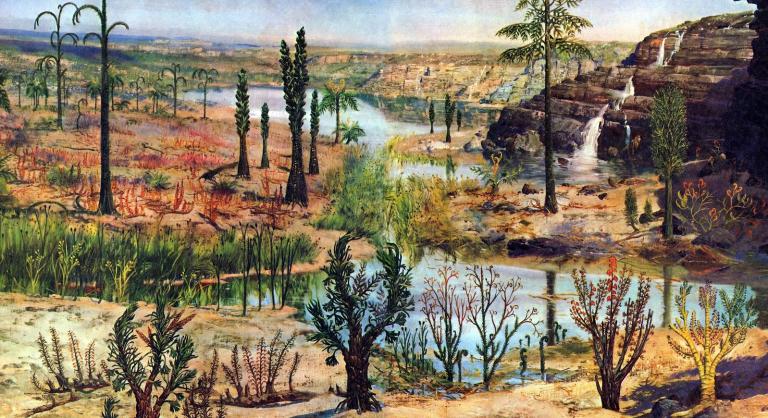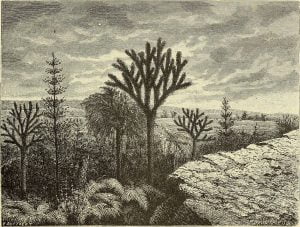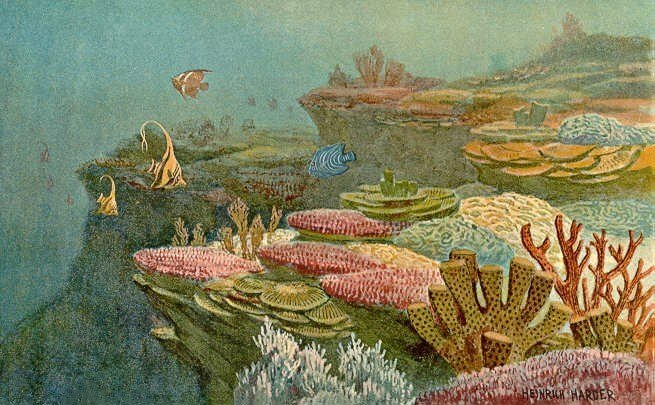Timeline 419.2 to 358.9 Million Years Ago Devonian Earth – The Age of Fishes and Forests

‘Devonian Earth’ – By the end of the Silurian period, 419.2-million years ago, the Earth’s continents were home to the first terrestrial ecosystems, but it was a very different land to what we know today. The Devonian period saw an explosion of both land-based plant and animal life and fishes.
For hundreds of millions of years before the first colonisation of the land by the first primitive plant life in the Ordovician period, the seas were teaming with life. The Silurian saw the first animal take a breath of air, living permanently on the land and forming the first purely land-based ecosystems. For millions of years, these primordial terrestrial ecosystems remained primitive and undeveloped, but that was all about to change with the appearance of the first true forests during the Devonian.
The Devonian is the fourth period of the Phanerozoic aeon and the third of the Palaeozoic era. Despite being the period that also saw the rapid spread of terrestrial life, the Devonian is often known as the ‘Age of Fish’ owing to an equally impressive marine radiation during the time.
Highlights of the Devonian

- Forests spread across the land
- The Golden Age of Fish
- Tetrapods colonise the land
- Development of reefs
- First insects learn to fly
- Mass extinction event
- 400 million years ago: The Great Race of Yith, fleeing catastrophe on their homeworld, transmit their minds into a race of cone-shaped creatures on Earth. They drive the Flying Polyps underground and imprison them there. Following that war, they build their first and greatest city, Pnakotus, in Terra Australis .
- 370 million years ago: Amphibians arise on Earth. Chaugnar Faugn later creates the Miri Nigri from amphibian flesh, as a servitor race.
Ancient Bugs Vie for Terrestrial Dominance
Devonian Earth is a tropical paradise. Oceans covered some 85% of the world’s surface, and global temperatures rose to 40% higher than they are today. The poles were free of ice during this period. Oxygen levels continued to rise as well, plants spread across river banks and coastlines and beyond.
Long before mammals and reptiles existed, it was bugs that ruled the land, bugs that would, in the Carboniferous Period, reach gigantic proportions. With the spread of terrestrial plant life providing sustenance for all manner of new terrestrial animals, more and more life started to crawl out of the sea. No longer was the tiny Silurian millipede, alone in the terrestrial world. By the Late Devonian, it had plenty of company in the form of scorpions, carnivorous centipedes and the flightless insects.
… and Placoderms Dominate the Oceans
The Devonian Period is often described as the Age of Fish, a fact perhaps best exemplified by the enormous dunkleosteus.
Numerous other orders of fish evolved during the Devonian, including the coelacanth. Primitive sharks were also well-established, diversifying greatly towards the end of the Devonian to include species like the peculiar stethacanthus, a shark characterised by its anvil-shaped dorsal fin.
Invertebrates continued to enjoy a great deal of success throughout the Devonian too, as sponges and corals built vast reefs, forming the foundations of ever-increasingly advanced marine ecosystems. Among the most significant is the iconic ammonite, a marine cephalopod that resembled nautiloids but is actually more closely related to octopi and squid.
The Late Devonian saw another extraordinarily important evolutionary event take place. While small arthropods had already been enjoying life on land for some 60-million years, it was now time for our own ancestors to step out of the water. 375-million years ago, a lobe-finned fish called a tiktaalik lived in the shallows. Although tiktaalik was probably predominantly amphibious, it used its limbs to push its way along the seabed and even lift itself up out of the water.
Forests Crawl across the Land
For billions of years, Earth’s lands had been barren and lonely. Even for the last 100-million years, terrestrial life had been mostly clinging to the coastal regions, apprehensive to evolve and colonise the lonely inland areas. However, that all changed in the Late Devonian when the continents underwent an unprecedented transformation, forming the very first forests. No longer were plants restricted to bush-sized lycopods, ferns and horsetails; now was the time of real woodland, such as the 100-foot-high (30 metres) archaeopteris. Although archaeopteris wasn’t technically a tree, it very much resembled one, despite having fern-like structures in place of leaves. Towards the end of the Devonian, the proliferation of sophisticated terrestrial plant life was so great that atmospheric oxygen levels started to skyrocket, a change that had profound effects and largely shaped the Carboniferous Period.
Ocean Life Chokes to Death in a Catastrophic Extinction Event

Coral reefs the world over were completely decimated by the Late Devonian mass extinction.
The Late Devonian saw one of the five greatest extinction events of the Phanerozoic aeon when the oceans appear to have choked to death with lack of oxygen.
Exactly what triggered the extinction remains uncertain, although various possibilities have been proposed, including widespread volcanism, an impact event or possibly the evolution of terrestrial ecosystems itself.
As the continents became green for the first time ever, the ubiquity of photosynthesising organisms may have drastically lowered CO2 levels, causing temperatures to plummet in the process.
Regardless of what triggered the extinction, anoxia, or reduced oxygen levels in the oceans, was the major killer, likely accompanied by dropping sea levels towards the end of the Devonian. Including the near complete disappearance of coral reefs and the extinction of many species of trilobite and brachiopods. Even the hardy dunkleosteus could not survive the profound changes to the ocean ecosystems; the most fearsome predator of the Devonian seas disappeared 360-million years ago.
Conclusion
While the Devonian ended shortly after the decimation of many of the world’s maritime ecosystems, life continued to thrive on the land as fish learned to walk and the first insects took flight. The rapid greening of the land presented a world of new opportunities.
Fish reached substantial diversity during this time dominating almost every known aquatic environment. The ancestors of all four-limbed vertebrates began adapting to walking on land, as their strong pectoral and pelvic fins gradually evolved into legs. In the oceans, primitive sharks became more numerous.
375–360 Late Devonian extinction – By the late Devonian, the land had been colonized by plants and insects. In the oceans were massive reefs . The extinction only affected marine life. Due to changes in sea level and ocean anoxia, (where portions of the oceans became depleted in oxygen) triggered by oceanic volcanism.
The rise of the Aboleths
Aboleths were utterly self-centered as a race; among the first sentient beings in existence, and saw all things as theirs, having a particular loathing for land-dwelling creatures. Their enmity towards other races stemmed in part from their perception that these “upstart” races had stolen what was rightfully the aboleths’. All that stopped them from conquering the surface was their weakness on land.

 Buy me a coffee
Buy me a coffee